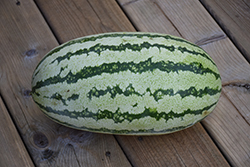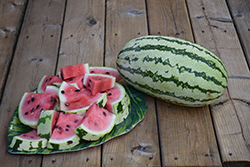Fri & Sat 8am - 8pm
Sun 8am - 7pm
Anytown, USA 12345
fax: 261.787.0463
e-mail: info@successgc.com


Plant Finder

Georgia Rattlesnake Watermelon
Citrullus lanatus 'Georgia Rattlesnake'
Height: 24 inches
Spacing: 3 feet
Sunlight:
![]()
Hardiness Zone: (annual)
Other Names: Gypsy Watermelon
Description:
A vigorous heirloom variety that produces large, oblong watermelons weighing around 30lbs; dark green and light green striped rind gives way to sweet and crisp red flesh; sprawling vines reach up to 8 feet long; open pollinated and resistant to bruising
Edible Qualities
Georgia Rattlesnake Watermelon is an annual vegetable plant that is typically grown for its edible qualities. It produces large light green oblong fruit with dark green stripes and red flesh which are typically harvested when mature. The fruits have a sweet taste and a juicy texture.
The fruit are most often used in the following ways:
- Fresh Eating
- Eating When Cooked/Prepared
- Juice-Making
- Freezing
Planting & Growing
Georgia Rattlesnake Watermelon will grow to be about 24 inches tall at maturity, with a spread of 8 feet. When planted in rows, individual plants should be spaced approximately 3 feet apart. Because of its vigorous growth habit, it may require staking or supplemental support. This vegetable plant is an annual, which means that it will grow for one season in your garden and then die after producing a crop. This is a self-pollinating variety, so it doesn't require a second plant nearby to set fruit.
This plant is typically grown in a designated vegetable garden. It should only be grown in full sunlight. It does best in average to evenly moist conditions, but will not tolerate standing water. This plant is a heavy feeder that requires frequent fertilizing throughout the growing season to perform at its best. It is not particular as to soil pH, but grows best in rich soils. It is somewhat tolerant of urban pollution. Consider applying a thick mulch around the root zone over the growing season to conserve soil moisture. This is a selected variety of a species not originally from North America, and it is considered by many to be an heirloom variety.

